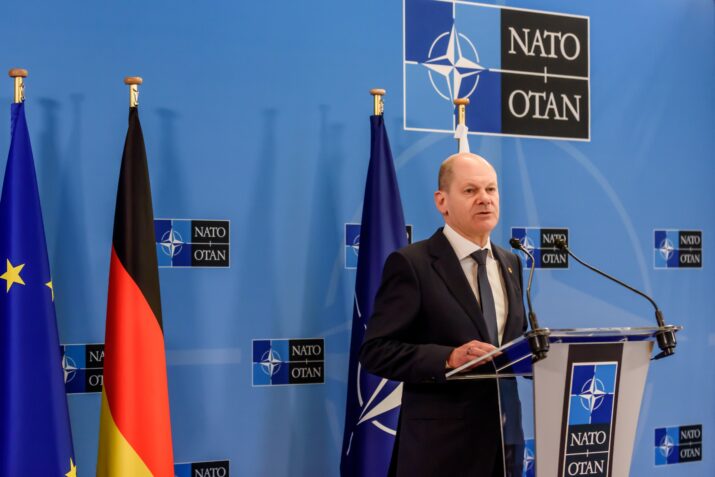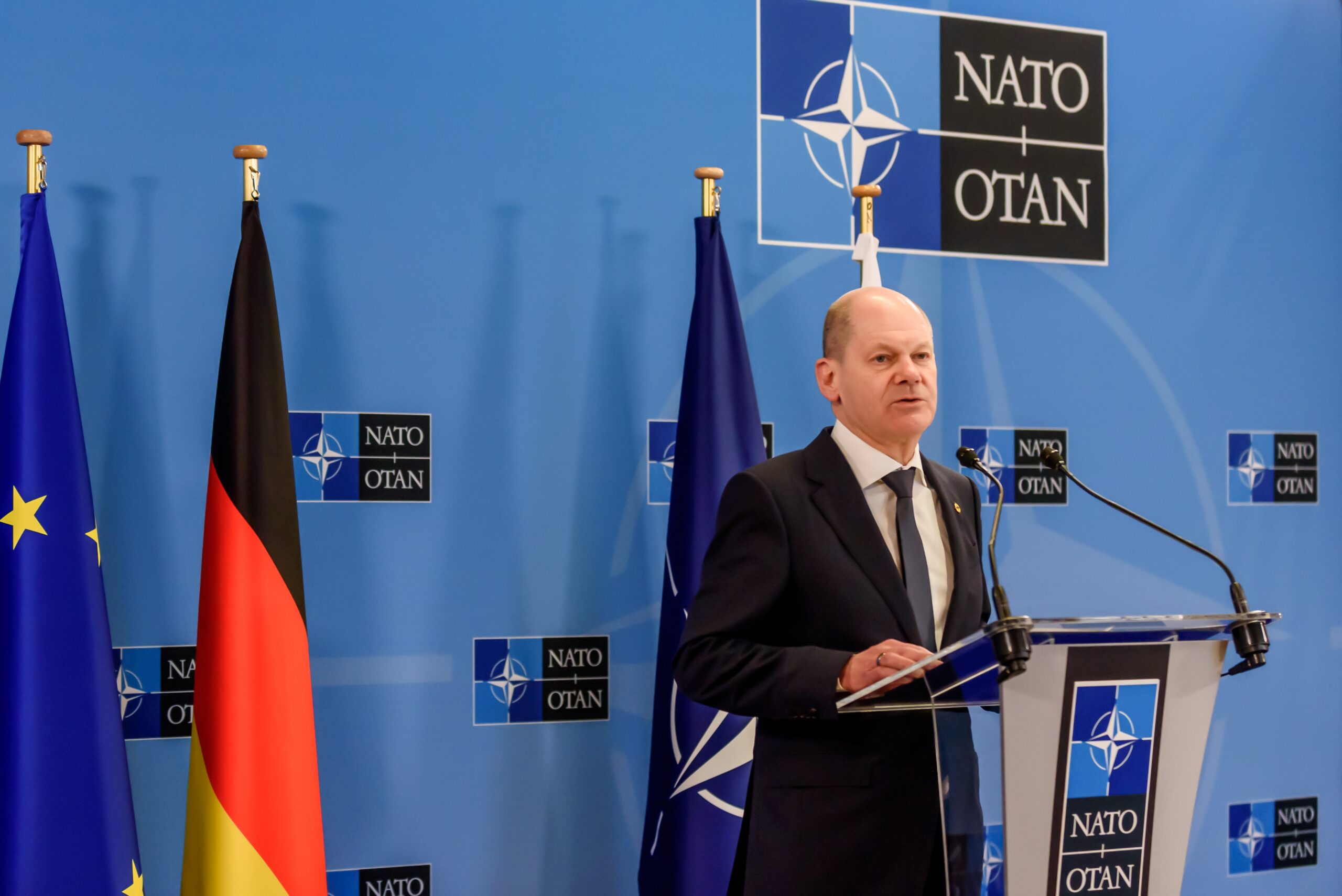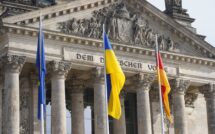

This is part of our special feature, Europe and NATO Since Ukraine.
Russia’s invasion of Ukraine threatens not only Ukraine but also the EU and NATO as institutions and individual member states. While the war has undoubtedly caused a Zeitenwende (watershed)—as German Chancellor Olaf Scholz proclaimed in February 2022—it remains undecided which of many paths Europe will take in facing its consequences. Depending on the outcome of the war, the landscape of European security may vary vastly. One vital change is already evident. While Western leaders have sought to keep Ukraine on the periphery of European affairs for many years, Ukraine is now at the center of European concerns.
Ukraine on Europe’s periphery
From the beginning of the post-Cold War era, there existed an imbalance between Ukraine’s relations with Russia and its relations with the EU and NATO. While Russia has consistently sought far more integration with Ukraine than Kyiv has been willing to accept, the EU and NATO have consistently offered much less than Ukraine has wanted. It is only after 2010 that the EU sought to institutionalize a closer relationship with Ukraine. Moreover, even after Russia invaded Ukraine in 2014, Europe continued to view Ukraine through its strategy of maintaining good relations with Russia at all costs. In the early 1990s, the EU and NATO focused on the new democracies of Central Europe and on the war in the former Yugoslavia. Ukraine’s primary Western interlocutor was the US, which viewed Ukraine almost solely in terms of its nuclear weapons until the 1994 Trilateral Nuclear Agreement. Meanwhile, the war in Yugoslavia showed that a Russian veto on European security was incompatible with European values and that NATO was indispensable rather than obsolete. Partly due to these realities and partly due to history, the newly liberated democracies of Central Europe lobbied intensely to be admitted into NATO. Russia’s policy on Yugoslavia was largely driven by domestic politics. The Russian democrats on whom the West placed its hopes, led by Boris Yeltsin, were on the ropes from the very beginning of the post-Cold War era. A so-called “red-brown” (communist-fascist) alliance was already forcing Yeltsin to change tack in 1993, and while much of the opposition to Yeltsin concerned domestic economic reforms, it was animated above all by the belief that Russia needed to regain control over Ukraine and reassert itself against the West.
In the fall of 1993, Yeltsin disbanded the Russian parliament and shelled it with tank fire when it resisted. The West supported Yeltsin, but Russian voters, in ensuing elections for a new parliament, preferred the neo-fascist Vladimir Zhirinovsky’s Liberal Democratic Party to Yeltsin’s Russia’s Choice Party. To anyone paying attention, Russian democracy was in deep trouble already in the early 1990s, and Russia was already determined to reassert itself both in what it called the “near abroad” and against the ascendent West. In February 1992, the London Times published an article entitled “Weimar Russia,” and a year later Yeltsin’s advisor Andranik Migranyan stated that “’Weimar Russia is no longer a metaphor.”[1] Zbigniew Brzezinski led the calls to respond to Russian revanchism by building up Ukraine: “It cannot be stressed strongly enough that without Ukraine, Russia ceases to be an empire, but with Ukraine suborned and then subordinated, Russia automatically becomes an empire.”[2] This strategy was adopted half-heartedly by the US and barely at all in Europe, in part because it contradicted the strategy that supported Yeltsin against nationalist opposition and in part due to the absence of reform in Ukraine. Engaging Ukraine was seen by Europeans as counter-productive to their relations with Russia, because it would further enrage Russian revanchists and undermine support for Yeltsin in Russia. Many Western elites subscribed to the Russian view that Ukraine was not really a distinct nation deserving its own state, although Ukraine was allowed to join NATO’s Partnership for Peace. Furthermore, Russia deployed threats and economic sanctions to force Ukrainian concessions on three issues: Ukraine’s nuclear weapons, membership in the Commonwealth of Independent States, and the status of Crimea, Sevastopol, and the Black Sea Fleet. Even the pro-western foreign minister Andrei Kozyrev said that “Sevastopol was Russia’s naval base and it must remain as such.”[3] The base from which Russia took over Crimea in 2014 was already a source of acrimony between the two countries in the 1990s. During that time, the West’s strategy was not to bolster Ukraine but to invest in Yeltsin as the hope of Russian democracy.
In June 1999, the European Union advanced a “Common Strategy of the European Union” on Russia. The document began with a statement: “A stable, democratic and prosperous Russia, firmly anchored in a united Europe free of new dividing lines, is essential to lasting peace on the continent.”[4] When Vladimir Putin came to power on New Year’s Eve, 1999, many in the West were relieved to see someone young, sober, and businesslike replacing the increasingly erratic Yeltsin. But Putin immediately began encroaching on the democracy on which the West’s policy depended, restarting a brutal war in Chechnya and methodically undermining sources of political opposition. He also renewed efforts to regain control of Ukraine, saying repeatedly, “We need to deal with Ukraine or we’ll lose it.”[5]
Many, both inside Ukraine and elsewhere, advocated that Ukraine should avoid choosing between Europe and Russia, but in terms of free trade, that was not possible. This impossibility was already evident in 2003, when Ukraine’s president Leonid Kuchma, increasingly isolated from the West due to his growing authoritarianism, agreed with Russia to create a vague “Common Economic Space” (CES). EU Commissioner Günter Verheugen pointed out that this economic space was incompatible with Ukraine joining the EU, which Ukraine claimed to want: “In case of establishing a customs union as part of the CES, the European integration process for Ukraine could be stepped down or even cease completely.”[6] The EU’s impending 2004 expansion unintentionally but inevitably forced the issue of EU relations with Ukraine. Expansion would put Ukraine on the EU’s border and would create trade barriers between Ukraine and Poland, a major trade partner. The European Neighborhood Policy (ENP) was designed to engage the EU’s new neighbors. Russia was invited, but it saw ENP as competing with its own plan to reassert its political and economic influence. While the ENP was modelled on the enlargement process, accession was not on the table for Ukraine. Requiring far-reaching domestic changes with no commitment to membership limited the EU’s leverage on Ukraine.
Ukraine’s 2004 Orange Revolution was a major turning point, ending the country’s slide toward authoritarianism and Russia and reconnecting it to Europe. It became clear that the success of Ukrainian democracy was incompatible with Ukraine keeping close relations with Russia. Europe provided economic aid and political support to the new government of Viktor Yushchenko. Russia cut the gas supply to Ukraine in 2006 and 2007, persuading the EU to get more directly involved in the gas trade in order to ameliorate the situation for European consumers. Simultaneously, however, Germany pursued the construction of the Nord Stream pipeline, which would immunize Germany and Russia from the consequences of a cutoff to Ukraine but leave Ukraine (and those supplied by pipelines traveling through Ukraine) more vulnerable. Polish Defense Minister Radoslaw Sikorski called Nord Stream the “Molotov–Ribbentrop pipeline,”[7] but Germany was undeterred, and the prevailing opinion in Europe remained that there was no alternative to engaging Russia. Meanwhile, infighting between Yushchenko and erstwhile ally Yuliya Tymoshenko squandered the momentum provided by the Orange Revolution.
The rift within the West opened by the US invasion of Iraq was on display at NATO’s Bucharest Summit in 2008. The US led support for giving Ukraine and Georgia Membership Action Plans (MAPs), while Germany and France led the opposition. A Polish delegate accused Germany of being “more worried for Moscow than for your allies.”[8] While a MAP was rejected, the Declaration released at the end of the summit stated that “We agreed today that these countries will become members of NATO.”[9] Russia interpreted this non-commitment as threat to its security and invaded Georgia later that year. While the invasion alarmed European and US leaders, they continued to believe that opposing Russian aggression was not a viable policy. US President Barack Obama, upon taking office in 2009, unilaterally declared a “reset” in US-Russia relations, in part to seek Russian help on issues such as Iran and its nuclear ambitions. Charles King wrote that the Georgian war “naturally raised the question: Is Sevastopol next?”[10] With Ukraine’s NATO membership deferred indefinitely, the EU became the most important western institution for Ukraine. In pursuing the integration of Ukraine in the Union, the EU did not see itself playing geopolitics; hence, it did not take seriously the idea that Russia was threatened by Ukraine’s integration into the EU.[11] Putin himself had said in 2004 that “If Ukraine wants to enter the EU and is welcomed there, then we can only be pleased.”[12]
From periphery to center
Yushchenko’s successor ,Viktor Yanukovych, turned Ukraine again toward authoritarianism and toward Russia but avidly pursued the Association Agreement (AA) and the Deep and Comprehensive Free Trade Agreement (DCFTA), both of which Ukraine had been negotiating with the European Union. As European Commission President Jose Manuel Barroso stressed, “One country cannot at the same time be a member of a customs union and be in a deep common free-trade area with the European Union. This is not possible.”[13] Putin agreed, despite his earlier statement, and began pressuring Yanukovych to drop the AA and instead join the Eurasian Customs Union that Russia was building. In 2013, as the EU and Yanukovych neared a compromise on the final barriers to signing the AA, Putin intervened personally, reportedly levelling a range of threats, including forcing a Ukrainian default, seizing Crimea, revealing the extent of Yanukovych’s corruption, and even killing him.[14] Just weeks before the Vilnius Summit, Yanukovych announced that Ukraine was ceasing work on the project of joining the EU. There was little the EU or its leaders could do other than try to broker a settlement in the crisis that emerged on the streets of Kyiv. After the worst violence there on February 20, 2014, three EU foreign ministers, along with a Russian representative, convinced Yanukovych to accept a deal he had rejected two days earlier that would leave him in power but require early elections. With his support evaporating, Yanukovych fled the next day, and Putin launched the seizure of Crimea.
The West’s response to Russia’s aggression was focused neither on confronting Russia nor on aiding Ukraine but on trying to limit the conflict to a level that would not require a more substantial response. In March 2014, NATO Secretary General Anders Fogh Rasmussen said that “this is not just about Ukraine. This crisis has serious implications for the security and stability of the Euro-Atlantic area as a whole.”[15] But the West was fractured along familiar lines regarding the severity of sanctions that should be imposed on Russia. German elites were deeply concerned about the potential impact of such sanctions on the German economy.[16] Even more supportive states such as the US refused to send “offensive” weapons to help Ukraine defend itself. While criticizing Russia for “the old pattern of thought that neighboring states are spheres of influence, and not partners,” German Chancellor Merkel echoed a widely articulated formula that “this conflict cannot be solved militarily.”[17] Instead, there followed two flawed attempts to find a diplomatic way out, the so-called Minsk agreements of September 2014 (Minsk 1) and February 2015 (Minsk 2).
In 2016, Ukraine and NATO agreed on a new “Comprehensive Assistance Package” to Ukraine. The plan focused on non-operational goals such as anti-corruption and democratic control but also addressed Ukraine’s C4 (Command, Control, Communications, and Computers), logistics, cyberwarfare resistance, and NATO interoperability, all of which contributed to Ukraine’s ability to fight more effectively. In 2017, Ukraine’s parliament passed a legislation stating that NATO membership was an objective of its foreign policy; and in 2019, Ukraine enshrined the objective of NATO membership in its constitution. EU-Ukraine cooperation also advanced incrementally. The Association Agreement entered into force on September 1, 2017. A program of technical and financial assistance focused on decentralization, rule of law support, and trade rule harmonization. The DCFTA eased Ukrainian agricultural and industrial exports to the EU. Between the 2014 revolution and mid-2021, EU aid to Ukraine totaled over €15 billion.[18] Between 2016 and 2019, Ukraine’s exports to and exports from the European Union increased by 49 percent.[19]
The West appeared satisfied with the post-Minsk-2 status quo in which none of the important issues were being resolved, but the decreased violence reduced the urgency to address the problem. Those so inclined could hope for a reduction in sanctions and a return to business as usual with Russia. Germany insisted on completing the Nord Stream 2 pipeline, which would deepen its dependence on Russian gas and further isolate Ukraine. The US and others strongly objected, but the Biden administration waived sanctions on the firms participating in the project in order to placate Germany. Similarly, while Ukrainian leaders insisted that Ukraine must eventually regain Crimea and the occupied Donbas, they had little incentive to escalate hostilities. Russia also appeared satisfied, because control of Crimea had become the new status quo and the ongoing war in the Donbas hamstrung the Ukrainian economy and kept NATO membership off its agenda.
When it became apparent in late 2021 that Russia was preparing to invade Ukraine, Western leaders sprang into action to try to diffuse the crisis. At the same time, however, they engaged in what was essentially an anti-deterrence strategy, stating publicly that NATO would not get involved in the war and that Russia would likely conquer Ukraine in a matter of days. One wonders whether Putin might have reconsidered the invasion had the West made clear how much financial and military support it was willing to give Ukraine. A half-century of European strategy led to the beliefs that the threat of economic sanctions would deter Putin and that imposing sanctions would devastate the Russian economy. The war invalidated these beliefs and the underlying strategy. However, the West’s response to the invasion has been significant in three respects. First, while the armaments provided to Ukraine have been insufficient to allow Ukraine to defeat Russian troops, they have allowed Ukraine to remain in the war. Second, Europe’s openness to Ukrainian refugees has significantly diminished human suffering. Third, both the EU and NATO have engaged in substantial institutional responses. NATO is expanding to take in Finland and Sweden, though including Ukraine is still a divisive question. The EU has deepened engagement with Ukraine, culminating with the decision in December 2023 to begin accession negotiations. Should Ukraine survive the war, the EU is expected to play a major role in reconstruction, although whether its member states will be able to muster the necessary funding to match their ambitions is questionable. However, decisions on armaments will be decisive. If Russia is able to defeat Ukraine on the battlefield, Ukraine’s membership in the EU or NATO will become irrelevant. Putin is betting on this.
What kind of Zeitenwende?
Russia’s war on Ukraine will undoubtedly constitute a watershed for the West, but perhaps not the one Olaf Scholz envisioned, in which Germany and Europe band together, defend Ukraine against Russia, and invest the sums necessary to dramatically augment their armed forces. A wide range of outcomes remain possible, and the path to the future of Europe hinges on choices made about Ukraine. At one extreme, European institutions would, as Scholz said, gain new validation from the defeat of Russia and would build a new purpose in the collective tasks of rebuilding Ukraine and resisting Russian revanchism. At the other, inaction and defeat would demoralize the West while empowering and encouraging Russia and those in the West who support it. For all the talk of a Zeitenwende, the West still appears reluctant to commit itself to Ukraine’s survival. The hope seems to be that if Russia were to conquer Ukraine, it would become a peaceful, status-quo power and that Europe could then avoid far-reaching change, keeping Ukraine on the periphery of the continent’s security. It is hard to believe that a Russian victory would turn out well for Europe. It is clear how it would turn out for Ukraine.
Paul D’Anieri is Professor of Political Science and Public Policy at the University of California, Riverside. He studies Ukrainian politics and foreign policy and Ukraine-Russia relations. His most recent book is Ukraine and Russia: From Civilized Divorce to Uncivil War, 2nd ed. (Cambridge: University of Cambridge Press, 2023), on which this essay draws.
[1] “Weimar Russia,” The Times (London), February 8, 1992; Migranyan is quoted in Mark Frankland, “Bruiser Yeltsin starts to rough up the enemy within,” The Observer, February 21 1993, p. 16.
[2] Zbigniew Brzezinski, “The Premature Partnership,” Foreign Affairs 73 (March/April 1994): 76.
[3] Interfax, December 7, 1993, quoted in Fiona Hill and Pamela Jewett, “’Back in the USSR’: Russia’s Intervention in the Internal Affairs of the Former Soviet Republics and the Implications for United States Policy Toward Russia,” John F. Kennedy School of Government, Harvard University, 1994, p. 85.
[4] Common Strategy of the European Union of 4 June 1999 on Russia (1999/414/CFSP), p. 1.
[5] Quoted in Mikhail Zygar, All the Kremlin’s Men: Inside the Court of Vladimir Putin (New York: PublicAffairs, 2016) p. 258.
[6] Igor Gretskiy, Evgeny Treshchenkov, and Konstantin Golubev, “Russia’s Perceptions and Misperceptions of the EU Eastern Partnership,” Communist and Post-Communist Studies 47, 3–4 (2014): 377.
[7] Rawi Abdelal, “The Profits of Power: Commerce and Realpolitik in Eurasia,” Review of International Political Economy 20, 3 (2013): 441.
[8] Quoted in Samuel Charap and Timothy Colton, Everyone Loses: The Ukraine Crisis and the Ruinous Contest for Post-Soviet Eurasia (London: Routledge, 2017), Everyone Loses, p. 88.
[9] “Bucharest Summit Declaration,” April 3, 2008, at https://www.nato.int/cps/en/natolive/official_texts_8443.htm.
[10] Charles King, “City on the Edge,” The American Interest 4, 5 (May 1, 2009) https://www.the-american-interest.com/2009/05/01/city-on-the-edge/.
[11] Cornelius Adebahr “Reconciling European Values and Western Interests in Ukraine,” European Leadership Network, July 4, 2014, at http://www.europeanleadershipnetwork.org/reconciling-european-values-and-western-interests-in-ukraine_1604.html.
[12] “Putin Says Russia Has no Objection to Ukraine’s Joining European Union,” Associated Press International, December 10, 2004.
[13] “EU to Ukraine: Reforms Necessary for Trade Pact,” Kyiv Post, February 25, 2013, https://archive.kyivpost.com/article/content/eu-ukraine-relations/eu-to-ukraine-reforms-necessary-for-trade-pact-320910.html
[14] Kataryna Ivanova, “Did Putin threaten to kill Yanukovych? Piontkovsky revealed exclusive details,” Obozrovatel, January 18, 2020, https://news.obozrevatel.com/ukr/russia/putin-pogrozhuvav-vbiti-yanukovicha-piontkovskij-rozkriv-eksklyuzivni-podrobitsi.htm.
[15] “Joint press point with NATO Secretary General Anders Fogh Rasmussen and the Prime Minister of Ukraine, Arsenii Yatseniuk,” March 6, 2014.
[16] Justin Huggler and Bruno Waterfield, “Ukraine Crisis: Russia Sanctions Would Hurt Germany’s Growth; Europe’s Biggest Economy Could Be Severely Affected by Future Sanctions against Russia,” The Telegraph, May 9, 2014.
[17] Alison Smale, “German Chancellor Rules Out Weapons Aid to Ukraine,” New York Times, February 2, 2015.
[18] European Union Delegation to Ukraine, “The European Union and Ukraine,” August 6, 2021.
[19] European Commission, “Ukraine: EU Trade relations with Ukraine. Facts, figures and latest developments.”
Photo: Shutterstock | BRUSSELS, BELGIUM. 24th March 2022. Olaf Scholz, Chancellor of Germany, during press conference after NATO extraordinary SUMMIT 2022.
Published on February 15, 2024.




